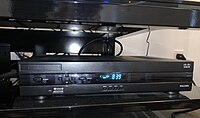This article needs additional citations for verification. (May 2023) |


Cable television is a system of delivering television programming to consumers via radio frequency (RF) signals transmitted through coaxial cables, or in more recent systems, light pulses through fibre-optic cables. This contrasts with broadcast television, in which the television signal is transmitted over-the-air by radio waves and received by a television antenna, or satellite television, in which the television signal is transmitted over-the-air by radio waves from a communications satellite and received by a satellite dish on the roof. FM radio programming, high-speed Internet, telephone services, and similar non-television services may also be provided through these cables. Analog television was standard in the 20th century, but since the 2000s, cable systems have been upgraded to digital cable operation.
A cable channel (sometimes known as a cable network) is a television network available via cable television. Many of the same channels are distributed through satellite television. Alternative terms include non-broadcast channel or programming service, the latter being mainly used in legal contexts. The abbreviation CATV is used in the US for cable television and originally stood for community antenna television, from cable television's origins in 1948; in areas where over-the-air TV reception was limited by distance from transmitters or mountainous terrain, large community antennas were constructed, and cable was run from them to individual homes.
In 1968, 6.4% of Americans had cable television. The number increased to 7.5% in 1978. By 1988, 52.8% of all households were using cable. The number further increased to 62.4% in 1994.[1]